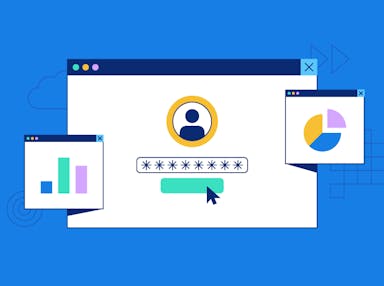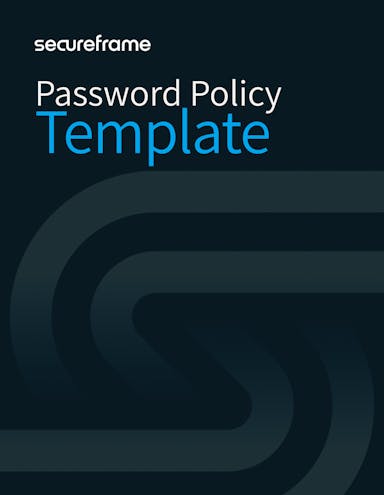
SOC 2 Password Requirements: What They Are & How to Comply
Anna Fitzgerald
Senior Content Marketing Manager
Rob Gutierrez
Senior Cybersecurity and Compliance Manager, CISA, CCSK, CMMC RP
Weak or compromised passwords remain a leading cause of data breaches. In Google Cloud’s latest Threat Horizons Report, weak or no credentials were behind nearly half (47%) of all cloud-based attacks during the first six months of 2024.
Strong password policies that ensure only authorized users can access sensitive systems and data are not only essential for mitigating the risk of data breaches — they are also mandatory to achieve and maintain SOC 2 compliance.
This article explores what SOC 2 password requirements are, best practices for secure password management, and how Secureframe can help organizations comply with these requirements and the SOC 2 framework as a whole.
What are SOC 2 password requirements?
SOC 2 is a leading security framework that covers how organizations should protect customer data from unauthorized access, security incidents, and other vulnerabilities. This framework defines requirements to manage and store customer data based on five Trust Services Criteria (TSC): security, availability, processing integrity, confidentiality, and privacy.

While organizations can pick which Trust Services Criteria they want to include in the scope of their audit, they must include the Security Criteria. In order to evaluate that an organization’s controls effectively meet the Security criteria, they must use another set of criteria known as the Common Criteria.
Common Criteria 6 (CC6) focuses on logical and physical access controls and provides "points of focus,” or examples of how an organization can satisfy requirements for this criteria. This is where password security measures and policies come in.
It’s important to note that the points of focus are not requirements. They are guidelines to help you better understand what you can do to meet each requirement and how an auditor will think about Security and any other applicable TSC when evaluating and testing your organization's controls.
So while SOC 2 does not specify exact password requirements for service organizations, it does require them to implement strong access controls that align with industry best practices.
Key considerations include:
- Minimum password length: Passwords should be at least 8 characters long to reduce the risk of brute-force attacks.
- Complexity requirements: Passwords should be required to have a mix of uppercase and lowercase letters, numbers, and special characters to enhance password security.
- Multi-factor authentication (MFA): Using an additional authentication factor, such as a one-time password (OTP) or biometric verification, significantly strengthens access control.
- Password cycling: Regular password updates (best practice is after no more than 90 days of use) help mitigate the risk of compromised credentials.
- No password reuse: Reuse of a password, or recycling, can significantly increase the risk of a data breach. This should be forbidden explicitly in your password policy.
- Account lockout: Limiting failed login attempts helps prevent brute-force attacks and unauthorized access.
- Storage and encryption: Passwords should be securely hashed and salted rather than stored in plaintext.
- User education: Employees and stakeholders should receive training on password hygiene and phishing awareness to minimize security risks.
- Mobile device management: An MDM tool can enforce strong passwords and monitor all in-scope devices.
- User access reviews: System owners should periodically conduct user access reviews of production servers, databases, and applications to validate internal user access is commensurate with job responsibilities.
- Access control and termination policy: You should document and maintain a policy that governs authentication and access to applicable systems, data, and networks.
- Principle of least privilege: Users should be provisioned access to systems based on the principle of least privilege.
Your organization should have a password policy that defines strong password requirements that align with current industry or national standards like the ones above.

Recommended reading

Strong Password Policy Essentials: Best Practices for 2025 + Template
Why SOC 2 password requirements are important
Password requirements play a critical role in maintaining the confidentiality, integrity, and availability of sensitive data. Weak password policies can lead to unauthorized access, data breaches, and regulatory non-compliance.
By enforcing strong password controls, organizations can:
Prevent unauthorized access
Strong password policies ensure that only authorized individuals can access critical systems and sensitive data. Without adequate password security, attackers can exploit weak credentials to gain entry, potentially leading to data theft, fraud, or operational disruption. By requiring strong, unique passwords, organizations can mitigate the risk of insider threats and unauthorized external access.
Mitigate data breach risks
Cybercriminals frequently use tactics like credential stuffing and brute-force attacks to compromise accounts. Enforcing complex passwords—along with additional security measures like multi-factor authentication (MFA)—significantly reduces the risk of such attacks. Strong passwords make it harder for attackers to guess or crack credentials, thus lowering the likelihood of data breaches.
Build trust
Implementing strong password requirements and demonstrating a commitment to security best practices helps build trust with customers, partners, and stakeholders. Organizations that prioritize password security signal to their clients that they take data protection seriously, which can be a key differentiator in competitive markets. By complying with SOC 2 requirements, businesses reinforce their reputation for security and reliability.
Ensure regulatory compliance
In addition to SOC 2, many industry regulations such as GDPR and HIPAA require organizations to maintain strict password security measures. Non-compliance can result in audit failures, reputational damage, and legal consequences. Implementing and enforcing strong password policies demonstrates a commitment to security best practices, helping organizations achieve regulatory compliance and maintain trust with clients and partners.
Support incident response efforts
When organizations have strong password policies in place, it becomes easier to detect and respond to unauthorized access attempts. Features such as account lockout policies, logging failed login attempts, and enforcing password expiration help security teams identify potential threats early. These measures enhance an organization’s ability to respond swiftly to security incidents and minimize damage.
Recommended reading

125+ Password Statistics to Inspire Better Security Practices in 2025
Best practices for meeting SOC 2 password requirements and enhancing overall password security
There are additional best practices that organizations can adopt to exceed SOC 2 requirements and enhance overall password security. These include:
- Implementing single sign-on (SSO): Reduces the need for multiple passwords while maintaining security through centralized authentication.
- Using a password manager: Encourages the creation of strong, unique passwords without the burden of memorization.
- Monitoring for compromised credentials: Regularly check for leaked passwords using dark web monitoring tools.
- Regularly auditing password policies: Conduct periodic reviews to ensure compliance with evolving security standards and best practices.

Download the password policy template
This free password policy template aligns with NIST guidelines and is designed to help organizations of all sizes enhance security while supporting compliance requirements. Download the template to customize it for your organization and start building a stronger cybersecurity foundation.
How Secureframe can help you meet SOC 2 password requirements
SOC 2 password requirements play a crucial role in securing sensitive data and preventing unauthorized access. By leveraging Secureframe’s compliance automation platform, organizations can implement strong password policies and streamline their SOC 2 journey.
Achieving and maintaining SOC 2 compliance can be complex, but Secureframe simplifies the process with:
- Automated gap analysis: Understanding what gaps exist in your controls and policies and how to fill them is essential for achieving and maintaining SOC 2 compliance. Secureframe automates this gap analysis so that, once you integrate the audit-relevant software and tools you use every day, you can see exactly what you need to do based on your unique configurations and IT infrastructure.
- Continuous monitoring: Secureframe continuously monitors your access and authentication controls to ensure alignment with SOC 2 requirements. This automation helps make continuous monitoring more cost-effective, consistent, and efficient.
- Automated remediation: Secureframe not only detects non-compliant password practices and recommends corrective actions — it can also automate the remediation process. Using Comply AI for Remediation, you can quickly fix any failing controls or tests and speed up time-to-compliance.
- Security awareness training: Secureframe provides proprietary employee training that meets SOC 2 requirements, and is reviewed and updated annually by compliance experts. It also automates the assignment, reminders, tracking, and reporting of security awareness training, so you can rest assured that employees are up-to-date on the latest password best practices and phishing prevention.
- Password management integrations and tests: We provide over 300 integrations, including integrations to several password managers like Dashlane, LastPass, and 1Password. We can automate the testing of certain requirements through integrations with these password managers and major cloud service providers, ensuring compliance with requirements without the manual burden.
- Policy templates: Policy templates, like our Access Control Policy template, help set password requirements and policies. Each template is written and approved by former auditors so you can quickly set up policies that fit your business needs and keep you compliant.
Ready to strengthen your password policies and simplify SOC 2 compliance? Request a demo with one of our product experts today.
FAQs
Does SOC 2 require specific password policies?
SOC 2 does not mandate specific password policies but requires organizations to implement strong access controls and password requirements and policies of some sort generally in line with industry best practices and standards.
What Common Criteria are related to password security and management?
CC6, which is focused on managing access control risks, has three subcategories that are related to password requirements. These are:
- CC6.1: The entity implements logical access security software, infrastructure, and architectures over protected information assets to protect them from security events to meet the entity's objectives.
- CC6.2: Prior to issuing system credentials and granting system access, the entity registers and authorizes new internal and external users whose access is administered by the entity. For those users whose access is administered by the entity, user system credentials are removed when user access is no longer authorized.
- CC6.3: The entity authorizes, modifies, or removes access to data, software, functions, and other protected information assets based on roles, responsibilities, or the system design and changes, giving consideration to the concepts of least privilege and segregation of duties, to meet the entity’s objectives.
How long should a password be to meet SOC 2 compliance?
A minimum of 8 characters is a recommended best practice, with a mix of uppercase and lowercase letters, numbers, and special characters for enhanced security.
Is multi-factor authentication (MFA) required for SOC 2 compliance?
While not explicitly required, MFA is a best practice and highly recommended to strengthen authentication controls and mitigate unauthorized access risks.
How often should passwords be changed under SOC 2 guidelines?
While SOC 2 does not specify password expiration policies, organizations should implement periodic password updates (e.g., every 90 days) to reduce security risks.
How can Secureframe help with SOC 2 password compliance?
Secureframe automates continuous control monitoring, enforces password policies, and provides audit-ready documentation to simplify compliance with password requirements and the SOC 2 framework overall.

Anna Fitzgerald
Senior Content Marketing Manager
Anna Fitzgerald is a digital and product marketing professional with nearly a decade of experience delivering high-quality content across highly regulated and technical industries, including healthcare, web development, and cybersecurity compliance. At Secureframe, she specializes in translating complex regulatory frameworks—such as CMMC, FedRAMP, NIST, and SOC 2—into practical resources that help organizations of all sizes and maturity levels meet evolving compliance requirements and improve their overall risk management strategy.

Rob Gutierrez
Senior Cybersecurity and Compliance Manager, CISA, CCSK, CMMC RP
Rob Gutierrez is an information security leader with nearly a decade of experience in GRC, IT audit, cybersecurity, FedRAMP, cloud, and supply chain assessments. As a former auditor and security consultant, Rob performed and managed CMMC, FedRAMP, FISMA, and other security and regulatory audits. At Secureframe, he’s helped hundreds of customers achieve compliance with federal and commercial frameworks, including NIST 800-171, NIST 800-53, FedRAMP, CMMC, SOC 2, and ISO 27001.